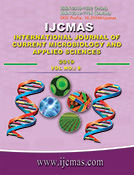


 National Academy of Agricultural Sciences (NAAS)
National Academy of Agricultural Sciences (NAAS)

|
PRINT ISSN : 2319-7692
Online ISSN : 2319-7706 Issues : 12 per year Publisher : Excellent Publishers Email : editorijcmas@gmail.com / submit@ijcmas.com Editor-in-chief: Dr.M.Prakash Index Copernicus ICV 2018: 95.39 NAAS RATING 2020: 5.38 |
In vitro study was conducted to study the effect of botanicals against hatching of Meloidogyne incognita egg masses. The aqueous extract of neem (Azadirachta indica) had the highest level of inhibition on hatching of nematode eggs (60.50 and 71.5% after 72 hr and 120 hr respectively). Significant increase in egg hatching inhibition as compared to neem was also observed at 120 hr interval (66.5 and 54.25 %) with Thulasi (Ocimum sanctum) and Calotropis (Calotropis gigantea) respectively. In control 100 % of egg hatching was found upto 48hrs.
 |
 |
 |
 |
 |